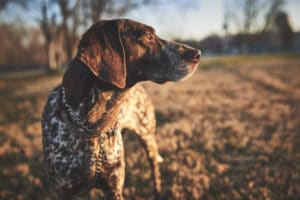While most of our dogs are spoiled pets that do no work harder than begging for treats, many dogs were originally bred for working. Knowing what your working dog was meant to do can really help you understand its behavior. If you are looking for a new dog, knowing about the breed(s) can help you pick one that fits your family.
Herding Dogs
Possibly best known from the famous collie depicted in “Lassie”, herding dogs (German Shepherds, Shetland sheepdogs, border collies, Cannan dogs, Komondors, etc) were bred to help ranchers move their livestock. In addition to herding, a lot of these breeds are naturally protective as well, making them good guard dogs and oftentimes reserved around strangers.
For household pets, this means your dog will most likely find a different outlet for this drive — from chasing the cat to herding the kids into a corner — which can be frustrating and even painful if he nips at your heels or calves while doing so. Find an outlet for him through rousing games of fetch, a local herding club, or competing in disc dog and agility. If you don’t give him a job, he will find one, and you might not like the one he chooses, like chewing all your shoes or trapping the cat in a corner for hours.
Bird Dogs
Some of the most popular breeds in the United States come from this group. Comprised of several types of dogs — pointers (German shorthair), retrievers (golden or Labrador), setters (English, Irish), flushers (cocker spaniel, springer spaniel), and water dogs (poodle, Portuguese water dog) — these breeds were developed to help hunters of fowl find and retrieve their game.
If your home is run by one of these happy-go-lucky breeds, you can be sure of two things. First, she has a lot of energy. Second, she probably jumps in the water any chance she gets. Smart and loyal, she will do best if given an outlet. Things like fetching, obedience, and dock diving are great. With all that energy comes a lovable, happy personality that makes bird dogs great with kids and amazing for therapy work.

Guard Dogs
Guardian breeds, including giant schnauzers, Tibetan mastiffs, Doberman pinschers, cane corsos, and the like, are oftentimes seen as aggressive and untrustworthy because they are ferocious when it comes to protecting their home. Remember, we bred them to be that way.
The most important thing for these dogs is socialization as puppies. Young dogs that are shown the world and as many strangers — kids, dogs, cats, etc. — as possible will be less aggressive as they get older. They are extremely intelligent and easy to train; this makes them amazing for any type of work you might want do — obedience, agility, therapy, search and rescue, etc.
Sight Dogs
Bred for helping hunters track prey by sight, breeds like the greyhound, Saluki, and the Irish wolfhound, are intensely visual and extremely fast. They will chase anything with quick movement (cats, kids, squirrels) and can be highly energetic. Like many working dog breeds, they too can be reserved around strangers.
For those who own or are thinking about getting a sight dog, stimulating their naturally acute eyesight is key. Activities such as fetch, disc dog, and lure-coursing, are thoroughly enjoyed by these breeds. Although this group includes the fastest dog breeds, they are known for being “couch potatoes” at home — if there is nothing to chase they are quite content to lay by their human pack leader.
Trackers
Like sight dogs, tracking dogs were bred to help hunt prey, but instead of using their eyes, they use their noses. Popular breeds like the beagle, bloodhound, and coonhound belong to the tracker group. Their amazing sense of smell is so instinctive that even dogs with no formal training will “track” a scent they pick up. If your dog picks up a scent, beware, he will most likely tune out everything else as his scent drive takes over.
Letting a hound off leash without proper recall training is not a good idea. A scent dog that finds a scent will be long gone, having tuned your voice out completely. With training, however, these amazing dogs are great for search and rescue and scent work.
Terriers
One of the most notorious groups, terriers were bred to be ostentatious hunters of game. The group, which includes the American Staffordshire terrier, the infamous Jack Russell and the perky West Highland terrier (westie), is well known for their stubborn, overbearing, energetic personalities.
Often referred to as “terror terriers,” dogs in this group need a firm hand when it comes to training or your house will be destroyed. Since they were bred to kill, these dogs love to rip, shred, chew, and shake anything they get their teeth into. Nip training and socialization are extremely important. Their intelligence makes them great for almost any type of activity, including agility, obedience, disc dog, and therapy work.
Regardless of what type of dog you love, if you understand your dog’s drives, you can train them to suppress their urges or to aim them at something acceptable, such as a chew toy rather than your Italian leather couch. Most importantly, take time to realize how incredible your dog’s natural abilities are and celebrate them.










